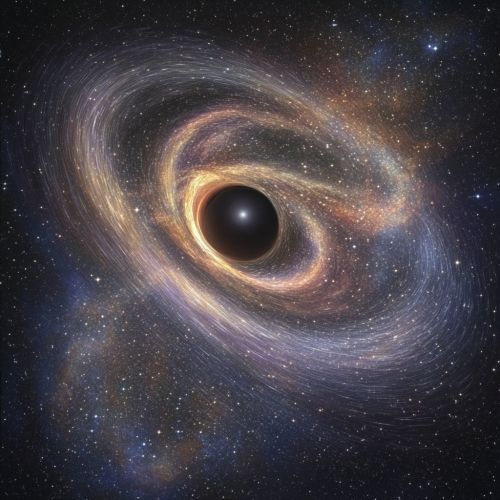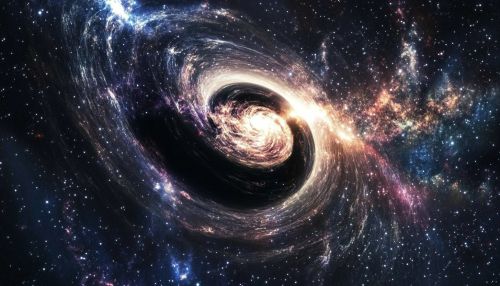Singularity (Physics)
Introduction
In the realm of physics, the concept of a singularity represents a point at which certain quantities become infinite or undefined. This notion is pivotal in the study of general relativity and cosmology, where singularities are often associated with the core of black holes and the initial state of the universe at the Big Bang. Singularities challenge the limits of our understanding, as they indicate regions where the known laws of physics cease to apply in their current form. This article delves into the intricate nature of singularities, exploring their mathematical formulation, physical implications, and the ongoing quest to comprehend their true nature.


Mathematical Formulation
The mathematical treatment of singularities primarily arises from the equations of general relativity, formulated by Albert Einstein. In this framework, a singularity is characterized by the divergence of the metric tensor, which describes the geometry of spacetime. The Einstein field equations, which relate the geometry of spacetime to the distribution of matter and energy, predict the formation of singularities under certain conditions.
Types of Singularities
Singularities can be classified based on their properties and the contexts in which they occur:
- **Curvature Singularities**: These are points where the curvature of spacetime becomes infinite. The most well-known example is the singularity at the center of a black hole, where the gravitational field is infinitely strong.
- **Coordinate Singularities**: These are apparent singularities that arise due to the choice of coordinate system rather than any intrinsic property of spacetime. An example is the event horizon of a black hole, which appears singular in certain coordinate systems but is not a true singularity.
- **Naked Singularities**: Hypothetical singularities not hidden behind an event horizon. Their existence would violate the cosmic censorship hypothesis, which posits that singularities are always cloaked by horizons, thus preserving the predictability of physical laws.
Mathematical Techniques
To analyze singularities, physicists employ various mathematical techniques, such as differential geometry and topology. These tools help in understanding the structure of singularities and their implications for the fabric of spacetime. The Penrose-Hawking singularity theorems provide conditions under which singularities are expected to form, based on the properties of spacetime and matter.
Physical Implications
The existence of singularities poses profound questions about the nature of reality and the limitations of current physical theories. Singularities are regions where the known laws of physics, including general relativity and quantum mechanics, break down, necessitating a new theoretical framework to describe them.
Black Holes
In the context of black holes, singularities represent the ultimate fate of matter collapsing under its own gravity. The Schwarzschild solution describes a non-rotating black hole with a singularity at its center. For rotating black holes, described by the Kerr solution, the singularity takes the form of a ring. These singularities are hidden behind event horizons, making them inaccessible to outside observers.
Cosmological Singularities
The Big Bang singularity marks the beginning of the universe, where density and temperature are thought to have been infinite. This singularity represents a boundary beyond which the classical description of spacetime breaks down. Understanding the Big Bang singularity is crucial for developing a comprehensive theory of cosmology.
Quantum Gravity
The quest to understand singularities has driven the search for a theory of quantum gravity, which seeks to unify general relativity with quantum mechanics. Approaches such as string theory and loop quantum gravity aim to provide a coherent description of singularities, potentially resolving the infinities and inconsistencies associated with them.
Challenges and Controversies
The study of singularities is fraught with challenges and controversies, as they highlight the limitations of current theories and the need for new paradigms.
Cosmic Censorship Hypothesis
Proposed by Roger Penrose, the cosmic censorship hypothesis suggests that singularities are always hidden from external observers by event horizons. This hypothesis remains unproven and is a subject of ongoing debate, as the existence of naked singularities would have profound implications for the predictability of physical laws.
Information Paradox
The black hole information paradox arises from the apparent loss of information when matter falls into a black hole, seemingly violating the principles of quantum mechanics. This paradox is closely linked to the nature of singularities and has spurred significant research into the reconciliation of general relativity and quantum mechanics.
Singularities in Quantum Field Theory
In quantum field theory, singularities manifest as divergences in calculations, such as the ultraviolet divergence encountered in quantum electrodynamics. Techniques like renormalization are employed to address these singularities, but they highlight the need for a more fundamental understanding of the underlying physics.
Future Directions
The study of singularities continues to be a vibrant area of research, with numerous avenues being explored to deepen our understanding.
Theoretical Developments
Efforts to develop a theory of quantum gravity remain at the forefront of singularity research. Advances in string theory, loop quantum gravity, and other approaches hold the promise of providing insights into the true nature of singularities and the fundamental structure of spacetime.
Observational Evidence
While singularities themselves are not directly observable, their effects can be inferred through astronomical observations. The study of gravitational waves, emitted during the merger of black holes, offers a new window into the behavior of singularities and the extreme conditions near them.
Computational Simulations
Advancements in computational techniques enable the simulation of singularities and the environments surrounding them. These simulations provide valuable insights into the dynamics of singularities and their interactions with the surrounding spacetime.
Conclusion
Singularities represent one of the most intriguing and challenging aspects of modern physics. They serve as a reminder of the limitations of our current understanding and the need for a deeper, more unified theory of the universe. As research continues, singularities remain at the cutting edge of theoretical and observational physics, offering the potential to unlock new realms of knowledge about the cosmos.
